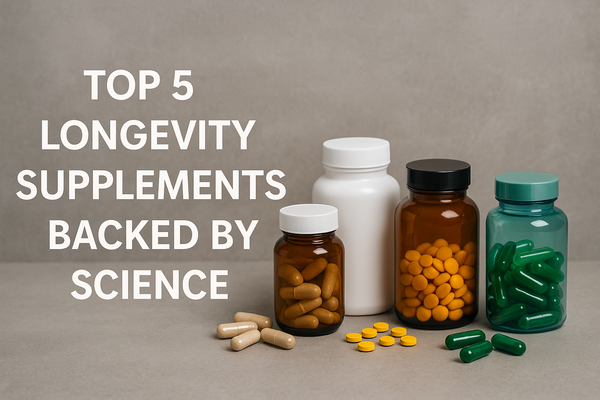By aSquared Nutrition Team
Introduction: Supplements Are Evolving
The supplement industry stands at a pivotal moment. For decades, consumers have relied on traditional capsules, tablets, and powders to meet their nutritional needs, often accepting suboptimal absorption rates and inconsistent results as simply "the way things are." But those days are rapidly coming to an end. Today's health-conscious consumers demand more than just basic vitamin delivery—they want higher absorption, better results, and formulations backed by cutting-edge science.
The next era of supplements will fundamentally shift focus from simply asking "what nutrients do I need?" to "how can these nutrients be delivered most effectively?" This represents a paradigm change from quantity-based thinking to bioavailability-focused innovation. No longer will consumers settle for supplements where only a fraction of the active ingredients actually reach their target tissues. Instead, they're seeking formulations that maximize every milligram through advanced delivery systems and synergistic combinations.
Three revolutionary innovations are leading this transformation: liposomal delivery systems that protect nutrients through the digestive process, bioenhanced blends that use natural compounds to multiply absorption, and smarter formulations that combine precision science with personalization technology. These aren't just incremental improvements—they represent a complete reimagining of how supplements can work with the human body rather than against its natural barriers.
At aSquared Nutrition, we're witnessing this evolution firsthand as consumers become more educated about bioavailability and more demanding about transparency. The future belongs to companies that can deliver not just promises, but proven results through superior science and innovative delivery methods.

The future of supplements: advanced delivery systems that work with your body's natural processes
Liposomal Delivery: Nutrients Encapsulated for Maximum Absorption
Imagine if you could protect your most valuable nutrients in tiny, biological armor that shields them from the harsh environment of your digestive system while ensuring they reach exactly where they need to go. This isn't science fiction—it's the reality of liposomal delivery technology, and it's revolutionizing how we think about supplement absorption.
Liposomes are microscopic spheres made from the same phospholipid materials that form our cell membranes. These tiny fat-like structures, typically measuring between 50-200 nanometers, act as protective vehicles that can encapsulate both water-soluble and fat-soluble nutrients. Think of them as biological submarines that can navigate through your digestive system, protecting their precious cargo from stomach acid, digestive enzymes, and other factors that typically destroy or reduce nutrient potency.
The science behind liposomal delivery is both elegant and powerful. When you consume a traditional supplement, it must survive the acidic environment of your stomach, navigate through your intestinal tract, and then somehow cross cellular barriers to reach your bloodstream. Many nutrients, particularly delicate compounds like vitamin C, glutathione, and curcumin, suffer significant degradation during this journey. Research shows that conventional oral supplements often have bioavailability rates as low as 10-20%.
Liposomal encapsulation changes this equation dramatically. The phospholipid bilayer structure of liposomes closely mimics our cell membranes, allowing them to merge seamlessly with intestinal cells and deliver their contents directly into the bloodstream. This process, known as endocytosis, bypasses many of the traditional barriers that limit nutrient absorption. Studies have demonstrated that liposomal delivery can increase bioavailability by 30-200% compared to conventional forms.
Bioenhanced Blends: Ingredients That Help Each Other Work Better
Nature has always understood something that modern supplement science is just beginning to fully appreciate: nutrients work better together. The concept of bioenhanced blends represents a return to this fundamental principle, but with the precision and understanding that only modern science can provide. These formulations don't just combine ingredients—they strategically pair compounds that can amplify each other's absorption, stability, and effectiveness.
The science of bioenhancement has deep roots in traditional medicine systems. In Ayurveda, the ancient Indian system of medicine, practitioners have long used a combination called "Trikatu"—consisting of black pepper, long pepper, and ginger—to enhance the effectiveness of other therapeutic compounds. What ancient healers understood intuitively, modern researchers have now validated through rigorous scientific study.
Piperine, the alkaloid responsible for black pepper's characteristic heat, remains the most well-studied and widely used bioenhancer in supplement formulations. The compound works through multiple mechanisms to enhance nutrient absorption, making it a versatile addition to various supplement formulations. Research has demonstrated that piperine can increase the bioavailability of different compounds by 30% to 200%. Perhaps most famously, piperine increases curcumin bioavailability by almost ten-fold when the two compounds are combined.

How bioenhancers work: combining nutrients with natural enhancers dramatically improves absorption
Smarter Formulations: Precision Meets Personalization
The era of one-size-fits-all supplementation is rapidly drawing to a close. In its place, a new paradigm is emerging—one that combines precision science with personalized health data to create supplement formulations that are as unique as the individuals taking them. This represents perhaps the most significant evolution in supplement science since the discovery of vitamins themselves.
Traditional supplement development has largely followed a broad-brush approach: identify a beneficial compound, determine a generally safe and effective dose, and market it to the widest possible audience. This approach has served the industry well for decades, but it ignores a fundamental truth about human biology—we are all biochemically unique. Factors such as genetics, age, sex, lifestyle, stress levels, sleep patterns, diet, exercise habits, and even gut microbiome composition all influence how our bodies process and utilize nutrients.
Modern smart formulations begin with a deep understanding of the complex interplay between nutrients, absorption mechanisms, and individual biological variations. Rather than simply combining popular ingredients, today's most advanced formulations are designed using sophisticated algorithms that consider multiple factors including nutrient synergies and antagonisms, temporal optimization, bioavailability matching, and stability engineering.

The future of personalized health: integrating technology with nutrition for optimal wellness outcomes
What This Means for the Future of Wellness
The convergence of liposomal delivery, bioenhanced blends, and smart formulations represents more than just incremental improvements in supplement technology—it signals a fundamental transformation in how we approach nutritional wellness. We are witnessing the birth of a new era where supplements will look less like generic pills and more like tailored wellness technology designed to work in harmony with individual biology.
This transformation is being driven by several powerful forces. Consumers are becoming increasingly sophisticated in their understanding of health and nutrition, demanding transparency, efficacy, and personalization. Scientific research is revealing the complex interplay between nutrients, genetics, lifestyle, and health outcomes. Technology is making it possible to analyze vast amounts of health data and create personalized recommendations at scale.
At aSquared Nutrition, we are committed to being at the forefront of this transformation. Our approach is grounded in three core principles: rigorous science, transparent communication, and genuine innovation that serves our customers' best interests. We believe that the future of supplementation lies not in marketing hype or trendy ingredients, but in the careful application of scientific principles to create formulations that truly work.
The future of supplements is smarter, stronger, and more effective. And that future is arriving now.
Click here to view our Berberine with Ceylon Cinnamon product.
References
[1] Shade, C. W. (2016). Liposomes as advanced delivery systems for nutraceuticals. Integrative Medicine: A Clinician's Journal, 15(1), 33-36. https://pmc.ncbi.nlm.nih.gov/articles/PMC4818067/
[2] Ko, J., Yoo, C., Xing, D., Gonzalez, D. E., Jenkins, V., et al. (2023). Pharmacokinetic analyses of liposomal and non-liposomal multivitamin/mineral formulations. Nutrients, 15(13), 3073. https://pmc.ncbi.nlm.nih.gov/articles/PMC10347199/
[3] Liu, W., Hou, Y., Jin, Y., Wang, Y., Xu, X., & Han, J. (2020). Research progress on liposomes: Application in food, digestion behavior and absorption mechanism. Trends in Food Science & Technology, 104, 177-189.
[4] Wbcil.com. (2025). Liposomal delivery system - bioavailability and clinical advantages. https://www.wbcil.com/blog/clinically-backed-and-market-proven-why-liposomes-are-todays-smartest-delivery-system/
[5] PlantaCorp. Liposomal bioavailability studies explained. https://plantacorp.com/liposomal-bioavailability-studies-explained/
[6] BodyBio. (2018). How liposomal supplements increase bioavailability. https://bodybio.com/blogs/blog/what-is-a-liposome
[7] Kumar, M. N., Kalarikkal, S. P., Bethi, C. M. S., Singh, S. N., et al. (2023). An eco-friendly one-pot extraction process for curcumin and its bioenhancer, piperine, from edible plants in exosome-like nanovesicles. Green Chemistry, 25, 4287-4301.
[8] Champion Bio. (2025). Liposomal supplements: Boosting bioavailability with advanced delivery. https://www.champion-bio.com/news-detail/liposomal-supplements-delivery-bioavailability/
[9] Kesarwani, K., & Gupta, R. (2013). Bioavailability enhancers of herbal origin: An overview. Asian Pacific Journal of Tropical Biomedicine, 3(4), 253-266. https://pmc.ncbi.nlm.nih.gov/articles/PMC3634921/
[10] Atal, C. K., et al. (1979). Discovery of piperine as the world's first bioavailability enhancer. Regional Research Laboratory, Jammu.
[11] Kesarwani, K., & Gupta, R. (2013). Bioavailability enhancers of herbal origin: An overview. Asian Pacific Journal of Tropical Biomedicine, 3(4), 253-266.
[12] Shoba, G., Joy, D., Joseph, T., Majeed, M., Rajendran, R., & Srinivas, P. S. (1998). Influence of piperine on the pharmacokinetics of curcumin in animals and human volunteers. Planta Medica, 64(4), 353-356.
[13] Atal, C. K., Dubey, R. K., & Singh, J. (1985). Biochemical basis of enhanced drug bioavailability by piperine: Evidence that piperine is a potent inhibitor of drug metabolism. Journal of Pharmacology and Experimental Therapeutics, 232(1), 258-262.
[14] Bhardwaj, R. K., Glaeser, H., Becquemont, L., Klotz, U., Gupta, S. K., & Fromm, M. F. (2002). Piperine, a major constituent of black pepper, inhibits human P-glycoprotein and CYP3A4. Journal of Pharmacology and Experimental Therapeutics, 302(2), 645-650.
[15] Reen, R. K., Wiebel, F. J., & Singh, J. (1997). Piperine inhibits aflatoxin B1-induced cytotoxicity and genotoxicity in V79 Chinese hamster cells genetically engineered to express rat cytochrome P4502B1. Journal of Ethnopharmacology, 58(3), 165-173.
[16] Singh, J., Dubey, R. K., & Atal, C. K. (1986). Piperine-mediated inhibition of glucuronidation activity in isolated epithelial cells of the guinea-pig small intestine: Evidence that piperine lowers the endogenous UDP-glucuronic acid content. Journal of Pharmacology and Experimental Therapeutics, 236(2), 488-493.
[17] Scheepens, A., Tan, K., & Paxton, J. W. (2010). Improving the oral bioavailability of beneficial polyphenols through designed synergies. Genes & Nutrition, 5(1), 75-87.
[18] Alexander, A., Qureshi, A., Kumari, L., Vaishnav, P., et al. (2014). Role of herbal bioactives as a potential bioavailability enhancer for active pharmaceutical ingredients. Fitoterapia, 97, 1-14.
[19] Chaachouay, N. (2025). Synergy, additive effects, and antagonism of drugs with plant bioactive compounds. Drugs and Drug Candidates, 4(1), 4.
[20] Singh, A., Ray, A., Mishra, R., et al. (2020). Phyto-phospholipid complexes: Innovative approach to enhance the bioavailability and therapeutic efficacy of herbal extract. Pharmaceutical Biosciences Journal, 8(2), 15-25.
[21] Pokushalov, E., Ponomarenko, A., Shrainer, E., et al. (2024). Biomarker-guided dietary supplementation: A narrative review of precision in personalized nutrition. Nutrients, 16(23), 4164. https://pmc.ncbi.nlm.nih.gov/articles/PMC11643751/
[22] Yoon, Y. S., Lee, H. I., Oh, S. W., & Lee, H. (2024). A life-stage approach to precision nutrition: A narrative review. Cureus, 16(8), e67089.
[23] Gahche, J. J., & Bailey, R. L. (2021). Accurate measurement of nutrients and nonnutritive dietary ingredients from dietary supplements is critical in the precision nutrition era. The Journal of Nutrition, 151(5), 1197-1205.
[24] Sempionatto, J. R., Montiel, V. R. V., Vargas, E., et al. (2021). Wearable and mobile sensors for personalized nutrition. ACS Sensors, 6(5), 1745-1760.
[25] Bioniq. (2025). The world's most personalized supplements. https://www.bioniq.com/
[26] Sharma, R., Gaur, S. S., Ajay, A., Shams, R., & Dash, K. K. (2025). Artificial intelligence and precision nutrition: tailoring diets with data-driven insights. Nutrire, 50(1), 1-15.
[27] Kahalkar, K., & Vyas, U. (2024). AI for personalized nutrition and healthcare management. 2024 2nd DMIHER International Conference on Biomedical Engineering, 1-6.
[28] Viome. (2025). Precision supplements: Personalized capsules. https://www.viome.com/products/precision-supplements
[29] Nourished. (2025). Nourished personalised gummy vitamins. https://us.get-nourished.com/
[30] Rasi Labs. (2025). Top 5 trends in supplement manufacturing for 2025. https://rasilabs.com/blogs/news/top-5-trends-in-supplement-manufacturing-for-2025
[31] GreyB. (2025). Precision nutrition innovations to watch in 2025. https://www.greyb.com/blog/precision-nutrition-innovations/
[32] Glanbia Nutritionals. (2025). Top 5 supplement trends for 2025. https://www.glanbianutritionals.com/en/nutri-knowledge-center/insights/top-5-supplement-trends






